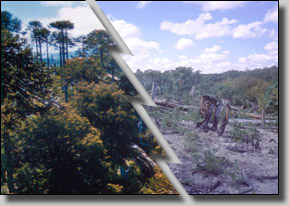Deforestation
6.01
Define the situation or problem
- Take the issue you have chosen and explain how it affects your community.
- My issue is deforestation. It is currently destroying wildlife habitats, also they are cutting down our tress and less trees means there is less oxygen
- My family believes that you're killing animals and their habitats where they live. I agree, but also we are putting our own lives in danger.
3. How does this issue affect households and local residents?
- It affects household and local residents by destroying the soil structure, also it causes erosion., and it takes away a habitat.
4.How does this issue affect area businesses?
- It can affect businesses by destroying it or if it floods the people may not be able to work.
5. How does this issue affect our government at the local, state, and national levels?
- It has no affect on government yet, they intend to build up.
6. How does this issue affect the rest of the world?
- It affects the rest of the world because it increase the CO2, which will eventually lead to global warming
8. How does the issue affect resources, goods and services, and finances?
- Increase runoff or unabsorbed rainfall.
Construct a circular-flow diagram that incorporates effects of your chosen issue on economic products and various sectors of the economy.
- REST OF THE WORLD
|
|
- GOVERNMENT
6.02
Identify the important criteria to evaluate possible solutions.
- What are the necessary conditions for any possible solution to work?
- More greenhouses instead of clearing out land for agricultural purposes. A more green conscious society would be very beneficial.
- Yes. It would be expensive to run on greenhouses and other means instead of deforestation. Labor would be cut drastically because many would not be needed anymore.
- YES !!
- Where will we get the products made from trees, those are some of the examples
5. How else might you judge possible solutions against each other?
- Completely cutting out deforestation may not be possible, so possibly a partial transition would be best.
-
“There is enough land already destroyed, we do not need to further
the problem. The regrowth of trees takes exponentially longer than
finding a different place to build.” –Mother
7. Should possible externalities factor into the chosen solution?
- Of course we should consider the externalities to make an open- minded decision.
6.03
Consider all possible solutions or alternatives.
- Give three possible solutions to the environmental issue you are investigating.
- Politic: enforcing laws
- Forest fiber products
Greenhouses
- Many would appose to these solutions because they are losing money.
Calculate the consequences of these solutions—both intended and unintended at all levels of the economy.
3. What positive or negative externalities does this issue present at each sector of the economy? Refer to your circular-flow diagram.- There would be less work available to those who cut down trees. The government could gain money from this. It would be more difficult to find household products. Things could be imported from other countries.
- The most basic incentive would be to help the environment and future generations to come.
5. What are the externalities, both positive and negative that could result from each possible solution?
- Negative externalities could be that jobs may be lost. Positive externalities would be that more people would move to our community who appreciate green living, therefore helping the economy and helping the cause.
6.04

Wilson, Carla. Indigenous people at risk as rainforests stripped bare, conference told. 2003. Web. 11 May 2012. <http://www.mapuche-nation.org/english/html/environmental/enviro-33.htm>.
“Deforestation Facts, Deforestation Information, Effects of Deforestation – National Geographic.” Environment Facts, Environment Science, Global Warming, Natural Disasters, Ecosystems, Green Living – National Geographic.
National Geographic, 2011. Web. 24 Nov. 2011.
<http://environment.nationalgeographic.com/environment/global-warming/deforestation-overview/>.
